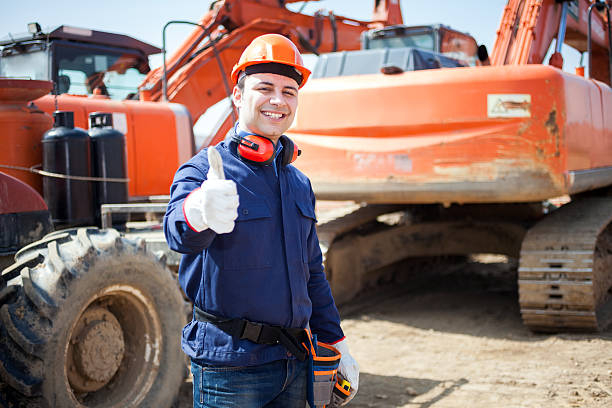
隨著全球基礎設施建設的不斷推進,工程機械的國際需求持續增加。對于許多企業來說,將工程機械出口到海外市場是一種有效的業務拓展方式,但成功的出口并非一蹴而就。它涉及多個關鍵環節,包括設備選擇、文件準備、物流安排以及合規性檢查。在本文中,我們將詳細介紹工程機械出口所需的主要條件和步驟,幫助企業順利將設備推向全球市場。
With the ongoing advancement of global infrastructure development, the international demand for construction machinery is steadily increasing. For many businesses, exporting construction machinery to overseas markets is an effective way to expand their operations. However, successful export is not achieved overnight. It involves several critical steps, including equipment selection, document preparation, logistics arrangements, and compliance checks. In this article, we will detail the essential requirements and steps needed for exporting construction machinery, helping businesses smoothly bring their equipment to the global market.
1. 設備選擇與評估
1. Equipment Selection and Evaluation
成功的工程機械出口始于正確的設備選擇。企業需要確保所選設備在目標市場具有競爭力,既能滿足客戶需求,又能符合當地的技術標準和環境要求。在出口之前,對設備進行全面的評估是至關重要的,這包括性能測試、維護記錄檢查以及設備的剩余使用壽命評估。
Successful construction machinery export starts with the right equipment selection. Businesses need to ensure that the chosen equipment is competitive in the target market, meeting customer demands while complying with local technical standards and environmental requirements. Comprehensive evaluation of the equipment before export is crucial, including performance testing, maintenance record checks, and assessing the remaining operational lifespan of the machinery.
性能測試:確保設備在高負荷下的穩定性和操作效率。
Performance Testing: Ensuring the machinery's stability and operational efficiency under heavy loads.
維護記錄:檢查設備的歷史維護記錄,確保設備處于良好狀態。
Maintenance Records: Reviewing the equipment's maintenance history to ensure it is in good condition.
使用壽命:評估設備的剩余使用壽命,以判斷其在目標市場的價值。
Operational Lifespan: Evaluating the remaining lifespan of the machinery to determine its value in the target market.
2. 文件準備與合規性
2. Document Preparation and Compliance
在工程機械出口過程中,文件準備是一個非常重要的環節。出口所需的文件不僅包括基本的商業文件,如發票、裝箱單和合同,還需要一些特定的合規文件,如原產地證書、出口許可證和進口國的合規證明。每個國家的進口法規和標準可能有所不同,企業需要確保所有文件齊全且符合目的地國家的要求。
Document preparation is a crucial step in the process of exporting construction machinery. The necessary export documents include not only basic commercial documents such as invoices, packing lists, and contracts but also specific compliance documents such as certificates of origin, export licenses, and compliance certificates required by the importing country. Each country has different import regulations and standards, so businesses need to ensure that all documents are complete and comply with the destination country's requirements.
Export Licenses: Apply for the necessary export licenses based on the type of equipment and the destination country.
原產地證書:提供設備制造地的證明文件,確保符合進口國的規定。
Certificates of Origin: Provide documentation proving the equipment's country of manufacture to comply with the importing country's regulations.
合規性證明:根據目的地國家的技術標準,提供必要的合規性認證。
Compliance Certificates: Provide necessary certifications to meet the technical standards of the destination country.
3. 物流與運輸安排
3. Logistics and Transportation Arrangements
工程機械通常體積大、重量重,因此在運輸安排上需要特別注意。企業需要選擇適合的運輸方式,如海運、空運或陸運,并確保設備在運輸過程中得到良好的保護。此外,還需要考慮裝載和卸載設備時的安全性,以及目的地國家的清關要求。
Construction machinery is often large and heavy, so special attention is needed when arranging transportation. Businesses must choose the appropriate transportation method, such as sea freight, air freight, or land transport, and ensure that the equipment is well-protected during transit. Additionally, the safety of loading and unloading the equipment and the customs clearance requirements of the destination country must also be considered.
運輸方式選擇:根據設備的尺寸和運輸距離,選擇最適合的運輸方式。
Transportation Method Selection: Choose the most suitable transportation method based on the equipment's size and the distance to be covered.
裝載與卸載:確保設備在裝載和卸載過程中不會受到損壞。
Loading and Unloading: Ensure that the machinery is not damaged during the loading and unloading process.
清關服務:提前了解目的地國家的清關要求,確保設備順利通過海關。
Customs Clearance Services: Understand the customs clearance requirements of the destination country in advance to ensure smooth customs processing.
4. 客戶服務與售后支持
4. Customer Service and After-Sales Support
成功的工程機械出口不僅僅是將設備運送到客戶手中,還包括提供優質的客戶服務和售后支持。企業需要為客戶提供設備的安裝指導、操作培訓以及維護建議,確保客戶能夠順利使用設備,并對服務感到滿意。良好的售后支持不僅有助于建立長期合作關系,還能提升企業的國際聲譽。
Successful construction machinery export involves more than just delivering the equipment to the customer; it also includes providing excellent customer service and after-sales support. Businesses need to offer installation guidance, operator training, and maintenance advice to ensure that customers can use the equipment smoothly and are satisfied with the service. Good after-sales support helps establish long-term business relationships and enhances the company's international reputation.
安裝指導:提供設備的安裝和調試服務,確保客戶能夠快速使用設備。
Installation Guidance: Provide installation and commissioning services to ensure customers can quickly start using the equipment.
操作培訓:為客戶提供操作培訓,幫助他們熟悉設備的使用方法。
Operator Training: Offer training to help customers familiarize themselves with the equipment's operation.
售后維護:提供定期維護服務和技術支持,確保設備的長期穩定運行。
After-Sales Maintenance: Provide regular maintenance services and technical support to ensure the long-term stable operation of the machinery.
結語:實現工程機械出口的關鍵
Conclusion: Key to Successful Construction Machinery Export
工程機械的出口涉及多個關鍵步驟,每一步都需要仔細規劃和執行。通過選擇合適的設備、準備齊全的文件、安排有效的物流和提供優質的售后支持,企業可以成功將設備出口到全球市場,滿足客戶的需求。上海挖百萬在工程機械出口方面擁有豐富的經驗和專業的服務,致力于幫助企業順利完成設備出口,為客戶提供全方位的支持。
Exporting construction machinery involves several critical steps, each requiring careful planning and execution. By selecting the right equipment, preparing complete documentation, arranging efficient logistics, and providing excellent after-sales support, businesses can successfully export their machinery to global markets and meet customer needs. Shanghai Wabaiwan has extensive experience and professional services in construction machinery export, dedicated to helping businesses complete their equipment exports smoothly and providing comprehensive support to customers.
管理員
該內容暫無評論